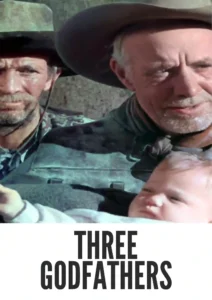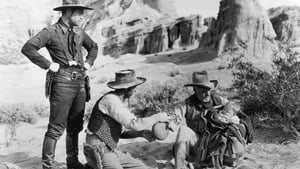Video Sources 0 Views
- Three Godfathers 1936 Colorized


Synopsis
Table of Contents
ToggleDesert Hearts and Cowboy Virtues: Three Godfathers (1936) in Vibrant Color

Embark on a heartwarming journey through the Wild West with Three Godfathers, a classic adventure film from 1936, now beautifully colorized for a captivating viewing experience. Also known as The Three Godfathers, this film delivers a touching blend of action, drama, and heartwarming moments as three outlaws find themselves responsible for a newborn baby in the harsh desert. Perfect for classic film enthusiasts and those seeking a feel-good western, this HD download brings a timeless tale of redemption and fatherhood to your screen.
Three Godfathers Storyline: An Unlikely Act of Kindness
Three Godfathers follows the story of three bank robbers, Bob Sangster (Chester Morris), Pete (Walter Brennan), and Gus (Richard Carle), who find themselves on the run from the law after a daring heist. While crossing the arid desert, they stumble upon a dying woman who entrusts them with the care of her newborn baby.With the relentless Sheriff Buck Sweet (Lewis Stone) hot on their trail, the three outlaws must navigate the unforgiving landscape while protecting the infant. Despite their rough exteriors, Bob, Pete, and Gus form a deep bond with the baby, facing numerous challenges and making selfless sacrifices to ensure his survival. The film culminates in a heartwarming courtroom scene where their actions are judged, showcasing the transformative power of love and compassion. Ultimately, Three Godfathers is a touching and inspiring story about redemption, sacrifice, and the true meaning of family.
Movie Cast
The film features a talented cast of actors who bring this heartwarming story to life:
- Chester Morris as Bob Sangster
- Walter Brennan as Pete
- Richard Carle as Gus
- Lewis Stone as Sheriff Buck Sweet
- Irene Hervey as Molly
Movie Genre
Three Godfathers falls into the genre of Western family adventure, with elements of drama and heartwarming moments that are characteristic of classic Hollywood cinema. Its themes of redemption, sacrifice, and the bond between unlikely caregivers and a child make it a captivating and emotionally resonant film.
Historical Context: A Christmas Classic and Sentimental Western
Released in 1936, Three Godfathers reflects the values and sentiments of the era, emphasizing themes of compassion, redemption, and the importance of family. The film was produced during a time when Westerns were a staple of American cinema, and it stands out for its focus on character development and emotional depth. While Three Godfathers has been remade several times, this original version remains a beloved classic, known for its heartwarming story and memorable performances.
Colorization Details
This colorized version of Three Godfathers has been meticulously restored using modern digital techniques, enhancing the visual appeal while preserving the film’s original charm and emotional impact. The colorization process involved carefully analyzing the grayscale tones of the original black and white footage and assigning appropriate colors to each scene. While the specific software used remains proprietary, the techniques employed included advanced algorithms for color palette selection and image enhancement. This painstaking process brings new life to the characters and settings, making the story even more engaging for modern audiences. While some may debate the merits of colorizing classic films, it introduces these films to a broader audience, ensuring their legacy for future generations.
Technical Details
- Director: Richard Boleslawski
- Screenplay: Edward E. Paramore, Manuel Seff, Kubec Glasmon
- Based on: the novel by Peter B. Kyne
- Cinematography: Joseph H. August
- Edited by: Frank E. Hull
- Production Company: Metro-Goldwyn-Mayer
- Distributed by: Metro-Goldwyn-Mayer
- Runtime: 82 minutes
Technical Specifications
- Download Format: MP4
- Resolution: HD (1080p)
- Compatibility: Compatible with most devices, including smartphones, tablets, computers, and smart TVs.
Reviews and Critical Reception
Three Godfathers (1936) is celebrated for its heartwarming story, memorable performances, and timeless themes. The film’s emotional depth and focus on character development set it apart from other Westerns of the era, and it continues to resonate with audiences today. As a beloved classic, Three Godfathers offers a poignant exploration of redemption, sacrifice, and the true meaning of family.
FAQs
- Q: What is Three Godfathers about?
- A: Three Godfathers is a Western adventure about three outlaws who become responsible for a newborn baby in the desert.
- Q: Is Three Godfathers (1936) a well-known Western film?
- A: Three Godfathers is a beloved classic, known for its heartwarming story and memorable performances.
- Q: Is this version of Three Godfathers colorized?
- A: Yes, this version has been professionally colorized to enhance the viewing experience.
- Q: What makes Three Godfathers interesting for classic film fans?
- A: Three Godfathers offers a poignant exploration of redemption, sacrifice, and the true meaning of family, with strong performances and timeless themes.
- Q: What is the download format?
- A: The download format is MP4, which is compatible with most devices.
- Q: What resolution is the download?
- A: The resolution is HD (1080p), providing a high-quality viewing experience.
Download Now in HD!
Watch Three Godfathers Today!











